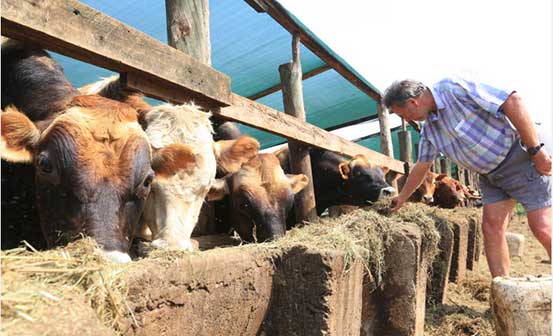Jimmy Brooks is often confident of a win whenever he displays his cattle at livestock shows. He anticipates getting the top prize for his Red Poll cattle, or the Boran breed he rears at Mazao Yetu Ltd farm in Koru, Kisumu County.
Today, Mazao rears approximately 1,100 cattle, with more than 400 Borans, another indigenous breed.
Mazao currently slaughters about 22 cattle every two to three months to supply East African Sea Foods with beef, and another two to three animals a week for a family shop in Kisumu. The farm also keeps Jersey cows for milk, and gets 760 to 1,200 litres from them each day, which is sold to the shop.
The Mazao Yetu managing director said his focus on these indigenous breeds, which many consider old fashioned or low producers, has given him the upper hand. “We rarely have competition in the Red Poll category because we are the only serious breeders in the country. Competition is good because it helps us improve the quality of meat and milk produced by our livestock,” Mr Brooks said.
Mazao Yetu is currently the only breeder rearing Red Polls, a dual-purpose breed of cattle, on a large scale. The farm has about 170 of the animals.
At the Brookside Livestock Breeders Show and Sale, Mazao’s animals have won the Supreme Champion Dual-Purpose Cow award in 2011 and 2013. Its Red Polls also won the Champion Bull gong against Sahiwal, Fleckvieh and Brown Swiss breeds in 2013. Brooks said many farmers are moving to exotic breeds of cattle, not knowing that with proper care, indigenous ones can give equally good quality milk and meat.
“Red Polls perform as well as, or even better than, pure dairy breeds, so we recommend them to smallholder farmers. Red Polls give as much milk as exotic dairy cows, yet they eat less,” he said. Red Polls are also good for beef production. Brooks’ family started rearing indigenous cattle several years back, and started out with about 250 animals.
Brooks, who is a Boran Cattle Breeders Society official, said he will be showing 21 animals — eight Red Polls and 13 Borans — at this year’s Brookside show scheduled for 21-23 July at the Jamhuri Park showground in Nairobi. The milk processor expects about 800 animals, including cattle, sheep, goats and camels, to be exhibited.
“The Boran breed is kept purely for beef. Since the early 20th century, commercial farmers started to improve the Boran breed after buying them from Northern Kenya. It is a beef animal that is better than exotic breeds,” Brooks said. “The Boran is an excellent walker, great converter of very poor quality forage, and is hardy and tick resistant. It is an ideal animal for many areas in Kenya. Ideally, Borans do well in arid areas, but this area of Koru has great rainfall and they are still doing fine.”
“For Boran cattle, if you want to have the best animal, you start by purchasing one from pastoralists in North Eastern. You should select good females with a good shape and meat in the right places to get cows that will breed regularly,” he said. The “right places” include plenty of flesh in the hind quarters and a broad back. “For the bulls, one animal works with 40 to 50 cows. So for each generation, you should select better males and females. This takes many years. Also, I only do breeding between indigenous breeds,” Brooks said.

